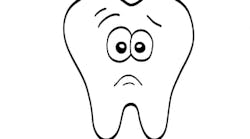Thursday Troubleshooter: Dental hygienist worries coding she's told to follow is unethical
Do you have a tough issue in your dental office that you would like addressed? Each week the experts on Team Troubleshooter will tackle those issues and provide you with answers. Send questions to [email protected].
QUESTION:I’m wondering if it’s legal or ethical that the PA161 program (I’m a RDH in Michigan) makes me code D1110 on a patient who hasn't been in in many years and presents with moderate to heavy calculus and stain, instead of coding a D4355 debride? I want to code to the insurance company and place on the files that I performed a D4355 debride and that I’m not done, but the Michigan PA161 program will only let me code a D1110 on all adults. Is this legal? I feel like this is unethical and illegal because I’m not done, it’s a preliminary procedure. I feel that a D1110 means gum tissue is pretty healthy with minimal supra/sub calculus. Thank you for your help!
ANSWER FROM PATTI DIGANGI, coauthor of DentalCodeology series of books:
Your question does not have information on any type of evaluation being performed. The D4355 code states specifically “to enable comprehensive evaluation and diagnosis” with the description saying, “this preliminary procedure.” This is a somewhat unique code. Most CDT codes are for completed procedures. D4355 is for care that is not complete. What you describe is incomplete care. Yet this does not mean D4355 is the most accurate code. If an evaluation has been completed, this code cannot be used.
If an evaluation has been completed, what is the diagnosis? The general descriptor of the oral evaluations in CDT states, “The collection and recording of some data and components of the dental examination may be delegated; however, the evaluation, which includes diagnosis and treatment planning, is the responsibility of the dentist.” The words “diagnosis” and “treatment planning” are key here. The courts have litigated this issue over and over; if it isn’t written, it wasn’t done. The question becomes, what is the patient diagnosis and treatment plan? In other words, if this practice is requiring you to record D1110 prophylaxis as the treatment, what is the written diagnosis and treatment plan that shows the clear dental necessity for this care plan?
The problem is that a written diagnosis has not traditionally been recorded by many offices. This is why with the new D4346 code—which is scaling in the presence of generalized moderate or severe gingival inflammation, full mouth, after oral evaluation—the words oral evaluation are written into the name of the code itself. An evaluation must occur before this procedure can be completed.
Your concern about the legal and ethical aspect of this coding dilemma is well founded. This has come up often with the new D4346 code. Dental practices are required to use the most accurate code to describe the care rendered. To use a different code for the purpose of payment can be considered dental fraud.
Dr. Charles Blair states, “Dental fraud is any crime where an individual receives insurance money for filing a false claim, inflating a claim, or billing for services not rendered. Fraud is sometimes called the ‘hidden’ crime because we are all victims without even noticing it.”
For example, rather than using the new D4346, the office chooses to:
• Under-code as a prophylaxis procedure
• Over-code as a scaling and root planing procedure or gross debridement
It appears that your dilemma is very similar because a code is being used based on coverage. It is also very possible the person asking you to use the D1110 code does not understand the ramifications of using an incorrect code. Has your office had a discussion about coding? Have there been any training classes offered? Is coding discussed in team meetings? Avoiding fraud and proper coding is a team process. Without knowledge of the codes and how they’re being applied, there is a likelihood that insurance fraud is being committed.
RECENT THURSDAY TROUBLESHOOTERS
Motormouth coworker drives dental staff and patients crazy
The complex question of who gets priority at busy front office?
How to stop dental team member's alpha behavior
Do YOU have a tough issue in your dental office that you would like addressed?
Send your questions for the experts to answer. Responses will come from various consultants associated with Speaking Consulting Network and Dental Consultant Connection. Their members will take turns fielding your questions on DentistryIQ, because they are very familiar with addressing the tough issues. Hey, it's their job.
Send your questions to [email protected]. All inquiries will be answered anonymously every Thursday here on DIQ.
For the most current practice management headlines, click here.
For the most current dental headlines, click here.
About the Author
Team Troubleshooter
This column features questions from everyday people who work in dental practices, who have issues they would like addressed by the experts. It no longer runs regularly, but the questions sent in the past still apply to dental practices today. Search "Troubleshooter" on DentistryIQ to read more.
